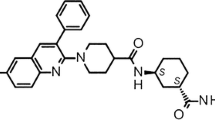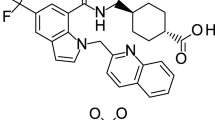Abstract
Despite its wide use, the mechanism of action of paracetamol (acetaminophen) is uncertain. It is commonly stated to be a weak inhibitor of the synthesis of prostaglandins (PGs) by the prostaglandin H synthases (COX-1 and COX-2) but paracetamol inhibits the synthesis of PGs in stimulated cultured cells with IC50 values ranging from 4 to 200 μM. Paradoxically, it generally stimulates PG production in broken cell preparations. Here we show that paracetamol inhibits the production of PGs in human rheumatoid synoviocytes during stimulation by interleukin1β (0.1ng/ml) for 18 h. Paracetamol inhibited the production of both PGE2 and PGF2αwith median IC50 values of 7.2 and 4.2 μM respectively, without affecting the or the level of the constitutive enzyme, COX-1 or the interleukin-1β mediated induction of both COX-2 and cytosolic phospholipase A2-α (cPLA2-α). These data indicate that paracetamol suppresses delayed PG production by direct modulation of the cPLA2-α /COX-2 pathway at therapeutic concentrations. Paracetamol is a substituted phenol and its effects on the synthesis of PGs are very similar to those of other phenols. Paracetamol should be considered to inhibit the production of PGs although the cause of its selectivity; analgesic and antipyretic effects with weak antiplatelet and anti-inflammatory effects is unknown.
Similar content being viewed by others
REFERENCES
Alanko, J., Riutta, A. and Vapaatalo, H. (1995). Phenols inhibit prostaglandinE2 synthesis in A23187-stimulated human whole blood and modify the ratio of arachidonic acid metabolites, Prost. Leuk. Ess. Fatty Acids 52, 299–301.
Anamura, S., Dohi, T., Shirakawa, M., et al. (1988). Effects of phenolic medicaments on prostaglandin synthesis by microsomes of bovine tooth pulp and rabbit kidney medulla, Arch. Oral Biol. 33, 555–560.
Bambai, B. and Kulmacz, R. J. (2000). Prostaglandin H synthase: Effects of peroxidase cosubstrates on cyclooxygenase velocity, J. Biol. Chem. 275, 27608–27614.
Berg, K. J., Djøseland, O., Gjellan, A., et al. (1990). Acute effects of paracetamol on prostaglandin synthesis and renal function in normal man and in patients with renal failure, Clin. Nephrol. 34, 255–262.
Bidgood, M. J., Jamal, O. S., Cunningham, A. M., et al. (2000). Type IIA secretory phospholipase A2 up-regulates cyclooxygenase-2 and amplifies cytokine-mediated synovial prostaglandin production in human rheumatoid synoviocytes, J. Immunol. 165, 2790–2797.
Bradley, J. D., Brandt, K. D., Katz, B. P., et al. (1992). Treatment of knee osteoarthritis: relationship of clinical features of joint inflammation to the response to a nonsteroidal antiinflammatory drug or pure analgesic, J. Rheumatol. 19, 1950–1954.
Brune, K. and Peskar, B. A. (1980). Paracetamol does not potentiate the acetylsalicylate inhibition of prostaglandin release from macrophages, Eur. J. Pharmacol. 68, 365–367.
Brune, K., Rainsford, K. D., Wagner, K. et al. (1981). Inhibition by anti-inflammatory drugs of prostaglandin production in cultured macrophages, Naunyn-Schmiedeberg's Arch. Pharmacol. 315, 269–278.
Cryer, B. and Feldman, M. (1998). Cyclooxygenase-1 and cycloxygenase-2selectivity of widely used nonsteroidal anti-inflammatory drugs, Amer. J. Med. 104, 413–421.
Dohi, T., Terada, H., Anamura, S., et al. (1989). The anti-inflammatory effects of phenolic dental medicaments as determined by mouse edema assay, Jap. J. Pharmacol. 49, 535–539.
Feldberg, W. and Gupta, K. P. (1973). Pyrogen fever and prostaglandin-like activity in cerebrospinal fluid, J. Physiol. 228, 41–53.
Feng, J. and Lipton, J. M. (1987). Eugenol: antipyretic activity in rabbits, Neuropharmacology 26, 1775–1778.
Flower, R. J. and Vane, J. R. (1972). Inhibition of prostaglandin synthase in brain explains the antipyretic activity of paracetamol (4-acetamidophenol), Nature 240, 410–411.
Graham, G. G., Day, R. O., Milligan, M. K., et al. (1999). Curent concepts of the actions of paracetamol (acetaminophen) and NSAIDs, Inflammopharmacology 7, 255–263.
Harvison, P. J., Egan, R. W., Gale, R. H., et al. (1988). Acetaminophen and analogs as cosubstrates and inhibitors of prostaglandin H synthase, Chem. Biol. Interact. 64, 251–266.
Hsuanyu, Y. and Dunford, H. B. (1992). Prostaglandin H synthase kinetics. The effect of substituted phenols on cyclooxygenase activity and the substituent effect on phenolic peroxidatic activity, J. Biol. Chem. 267, 17649–17657.
Jakobsson, P.-J., Thoren, S., Morgenstern, R., et al. (1999). Identification of human prostaglandin E synthase: A microsomal glutathione-dependent, inducible enzyme, constituting a potential novel drug target, Proc. Natl. Acad. Sci. USA 96, 7220–7225.
Landolfi, C., Soldi, L., Polenzani, L., et al. (1998) Inflammatory molecule release by amyloid-treated T98G astrocytomacells: role of prostaglandinsand modulation by paracetamol, Eur. J. Pharmacol. 360, 55–64.
Lazer, E. S., Wong, H. C., Possanza, G. J., et al. (1989). Antiinflammatory 2,6-di-tert-butyl-4-(2-arylethenyl)phenols,J. Med. Chem. 32, 100–104.
Lanz, R., Polster, P. and Brune, K. (1986) Antipyretic analgesics inhibit prostaglandin release from astrocytes and macrophages similarly, Eur. J. Pharmacol. 130, 105–109.
Lindgren, J. Å., Claesson, H.-E. and Hammarström, S. (1977). Inhibition of prostaglandinsynthesis in mouse 3T3 fibroblasts and human platelets by substituted phenols, Prostaglandins 13, 1093–1102.
Lipsky, P. E., Brooks, P., Crofford L. J., et al. (2000). Unresolved issues in the role of cyclooxygenase in normal physiologic processes and disease, Arch. Int. Med. 160, 913–920.
Malmberg, A. B. and Yaksh, T. L. (1994). Capsaicin-evoked prostaglandin E2 release in spinal cord slices: relative effect of cyclooxygenase inhibitors, Eur. J. Pharmacol. 271, 293–299.
Murakami, M., Naraba, H., Tanioka, T., et al. (2000). Regulation of prostaglandin E2 biosynthesis by membrane-associated prostaglandin E2 synthase that acts in concert with cyclooxygenase-2, J. Biol. Chem. 275, 32783–32792.
Muth-Selbach, U. S., Tegeder, I., Brune, K., et al. (1999). Acetaminophen inhibits spinal prostaglandinE2 release after peripheral noxious stimulation, Anesthesiology 91, 231–239.
Niemi, T. T., Backman, J. T., Syrjala, M. T., et al. (2000). Platelet dysfunction after intravenous ketorolac or propacetamol, Acta Anaes. Scand. 44, 69–74.
Potter, D. W. and Hinson, J. A. (1987). The 1-and 2-electron oxidation of acetaminophen catalyzed by prostaglandin H synthase, J. Biol. Chem. 262, 974–980.
Prescott, L. F. (1996). Paracetamol (acetaminophen): a critical bibliographic review. Taylor and Francis, London.
Prescott, L. F., Mattison, P., Menzies, D. G., et al. (1990). The comparative effects of paracetamol and indomethacin on renal function in healthy female volunteers, Brit. J. Clin. Pharmacol. 29, 403–412.
Robak, J., Wiekowski, A. and Gryglewski, R. (1978). The effect of 4-acetamidophenol on prostaglandin synthetase activity in bovine and ram seminal vesicle microsomes, Biochem. Pharmacol. 27, 393–396.
Rotilio, D., Joseph, D., Hatmi, M., et al. (1984). Structural requirements for preventing the aspirin-and the arachidonate-induced inactivation of platelet cyclo-oxygenase: additional evidence for distinct enzymatic sites, Eur. J. Pharmacol. 97, 197–208.
Scott, K. F., Bryant, K. J. and Bidgood, M. J. (1999). Functional coupling and diferential regulation of the phospholipase A2-cyclooxygenase pathways in inflammation, J. Leukocyt. Biol. 66, 535–541.
Seppälä, E., Nissilä, M. Isomäki, H., et al. (1985). Comparison of the effects of different anti-inflammatory drugs on synovial fluid prostanoid concentrations in patients with rheumatoid arthritis, Clin. Rheumatol. 4, 315–320.
Simmons, D. L., Botting, R. M., Robertson, P. M., et al. (1999). Induction of an acetaminophen-sensitive cyclooxygenase with reduced sensitivity to non-steroid antiinflammatory drugs, Proc. Natl. Acad. Sci. USA 96, 3275–3280.
Skjelbred, P. and Lokken, P. (1979). Paracetamol versus placebo: effects on postoperative course, Eur. J. Clin. Pharmacol 15, 27–33.
Srivastava, J. C. (1993). Antiplatelet principles from a food spice clove, Prost. Leuk. Ess. Fatty Acids 48, 363–372.
Thompson, D. and Eling, T. (1989). Mechanism of inhibition of prostaglandin H synthase by eugenol and other phenolic peroxidase substrates, Mol. Pharmacol. 36, 809–817.
Willoughby, D. A., Moore, A. R. and Colville-Nash, P. R. (2000). COX-1, COX-2, and COX-3 and the future treatment of chronic inflammatory disease, Lancet 355, 646–648.
Author information
Authors and Affiliations
Rights and permissions
About this article
Cite this article
Graham, G.G., Robins, SA., Bryant, K.J. et al. Inhibition of prostaglandin synthesis in intact cells by paracetamol (acetaminophen). Inflammopharmacology 9, 131–142 (2001). https://doi.org/10.1163/156856001300248407
Issue Date:
DOI: https://doi.org/10.1163/156856001300248407




